Boat Navigation Lights Rules: Illustrated Beginners Guide
When navigating at night, the lights on other boats are your first clue about the moving dangers around you. And your navigation lights are your first line of safety in avoiding collisions in the dark, and they tell others vessels what you are and what you are doing. The rules sound complex, but with a little understanding you can get the basics for any situation.
So what are the basic navigation light rules? For most small vessels, motoring requires red and green (port and starboard) lights, and a white light visible in all directions around the boat. This is almost always a stern light and a masthead light on sailboats. Boats under sail require port and starboard lights, and a white stern light. Sailboats below sixty-five feet may show a tricolor light at the masthead instead of side and stern lights when sailing.
That's it, in a nutshell. There's a little more to it, as the rules change with different sizes and there are some specifics about angles of display for the colors. Identifying other ships at sea requires more study, but the basics are the same. And it's not much trouble to make sure you've always got the proper lights on your vessel.
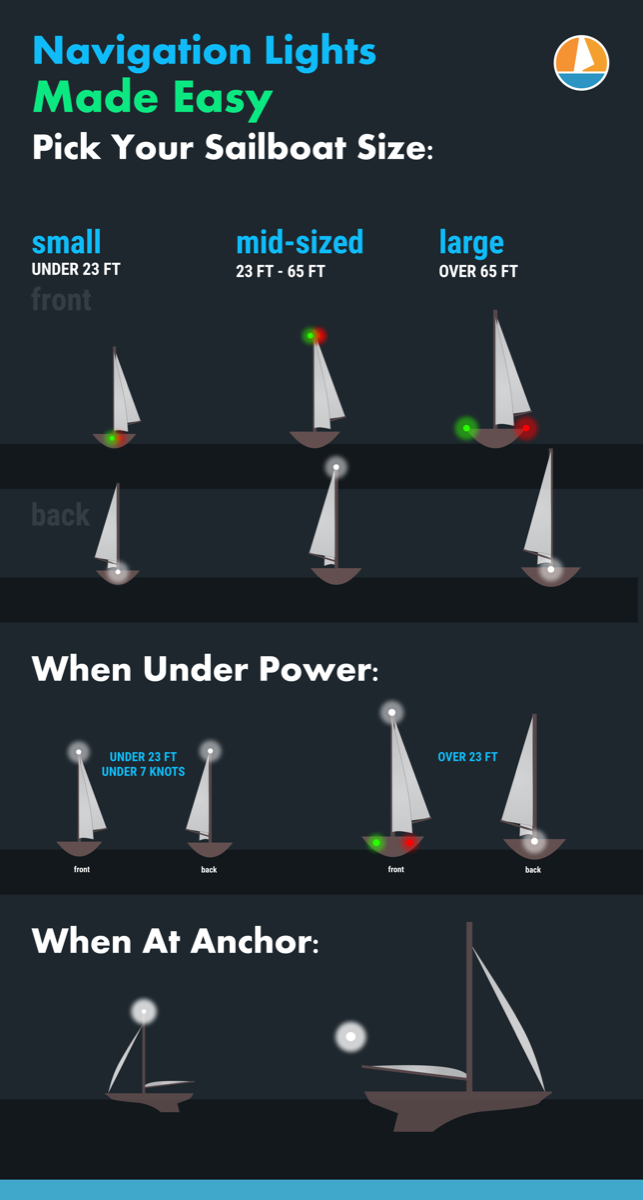
What are the official COLREGS rules for your sailboat?
The International Regulations for the Prevention of Collision at Sea, abbreviated "COLREGS" is very specific about the lights required, their shapes and sizes, and the distance they must be visible. For the smaller boat, the following definitions apply.
- Masthead Light - a white light placed centerline on the boat showing an arc of 225 degrees with 112.5 degrees either side of the front of the vessel.
- Sidelights - A red light on the port side and a green light on the starboard. They must show an arc of 112.5 degrees from centerline of the bow.
- Stern light - A white light on the stern of the boat showing an unbroken arc of 135 degrees from centerline of the vessel.
- All-round light - A light showing in an unbroken arc of 360 degrees.
The good news is you need not measure these angles. Any properly installed USCG or COLREGS approved light which will cover the correct arcs. If you have to replace the original light from your boat, make sure it's with an approved replacement.
Lights When Sailing
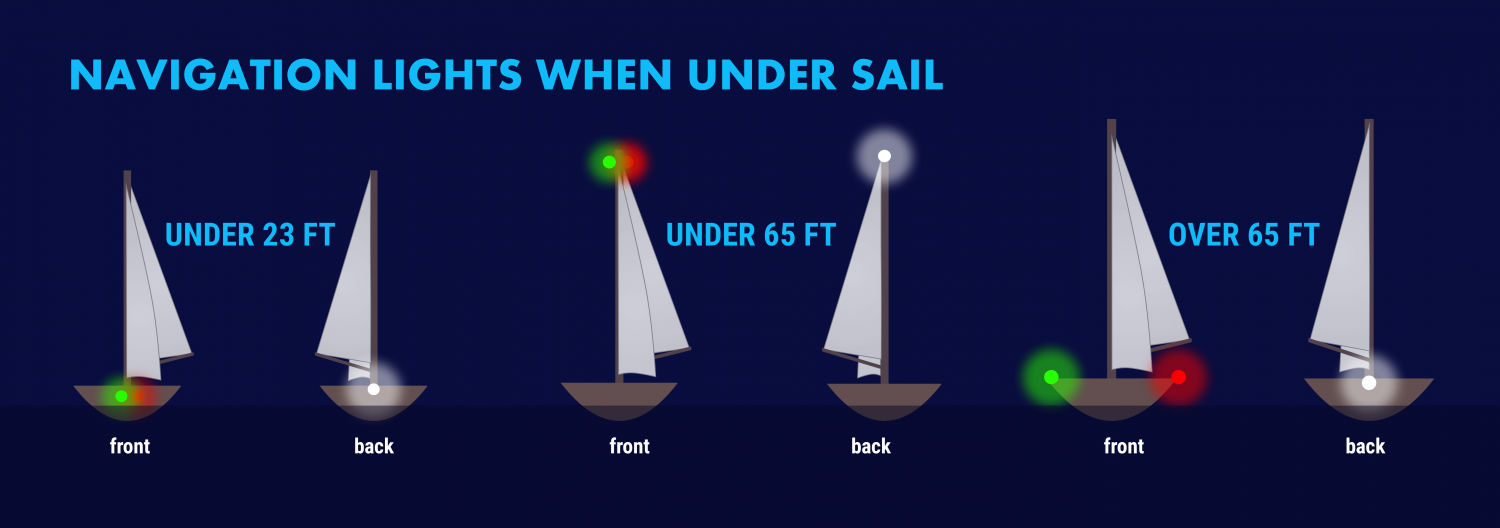
The specific rules for a sailboat under sail are in COLREGS Rule 25 and vary slightly with the size of the boat. A sailboat powering is considered a power boat and falls under in Rule 23.
- Under 23 feet (7 meters) - side lights and a stern light, possible. If these lights can not be displayed a light must be kept at hand to help avoid a collision. This can be a bright flashlight.
- Over 23 feet - Side lights visible to one nautical mile and stern light visible for two.
- Less than 65 feet (20m) -
- Vessels under 65 feet may combine both sidelights into a single lantern on the bow.
- May show a tricolor light on the masthead instead of sidelights and a stern light. It's one or the other though, do not show these lights at the same time.
- Masthead light must be visible for three nautical miles, all other lights must have a two nautical mile visibility.
- Over 65 Feet -
- Side lights must be separated.
- May not show a masthead tricolor light.
- Masthead light must have five nautical mile visibility, all other lights must be visible for two nautical miles.
- Optional masthead lights - any vessel under sail may display a red light over a green light at the masthead with sidelights and stern light. The red over green may NOT be displayed with a masthead tricolor light. It's one set or the other.
Lights When Motoring
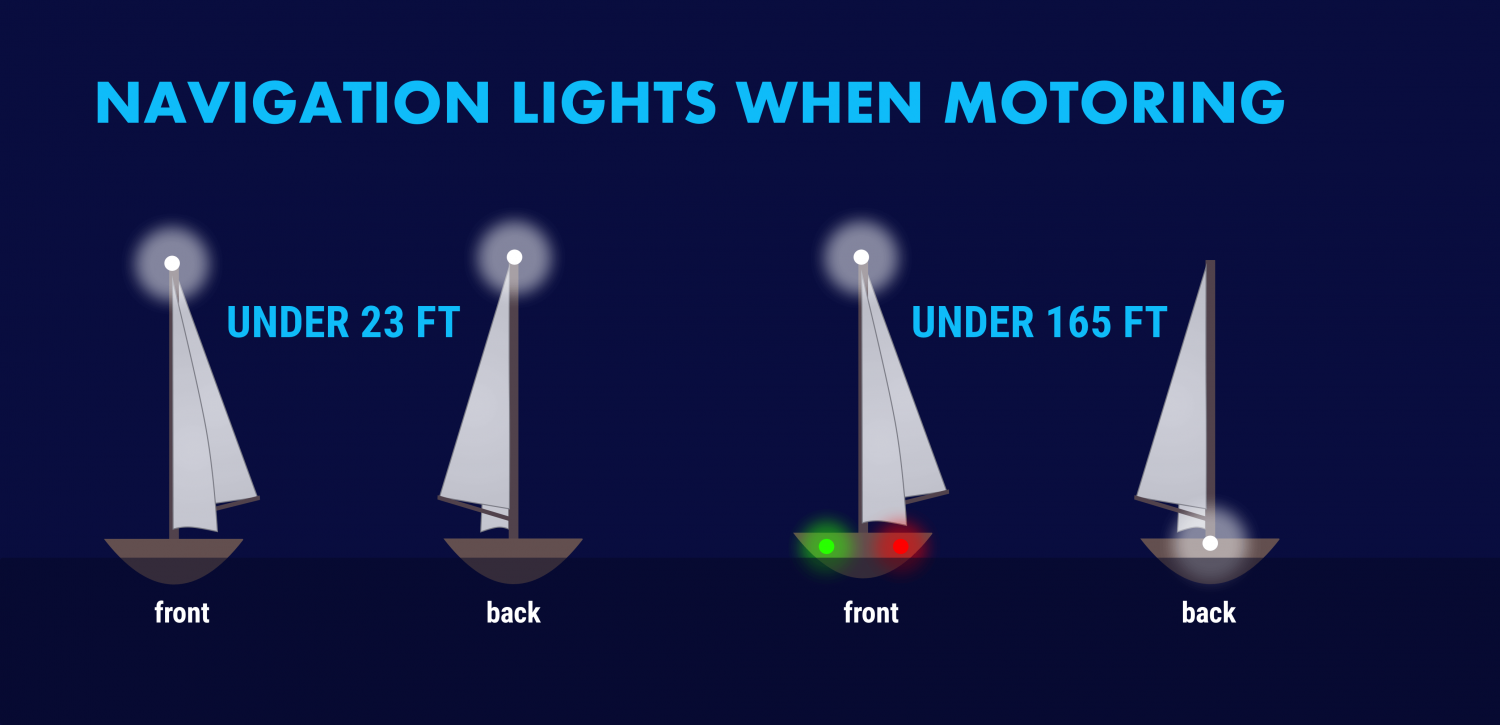
For all navigational purposes a sailboat under power is considered a power boat. This includes motor sailing - if the engine is on and providing propulsion you are on a power boat, even if the sails are up. This applies to navigation lighting, sound signals in fog and limited visibility, and rights of way.
Sailboats under 50 meters under power need to show:
- A masthead light
- Sidelights
- Stern light
A power-driven vessel under 23 feet (7 meters) that does not exceed seven knots of speed may display an all around white light, though sidelights should be used if available.

What about the USCG (United States Coast Guard) Rules?
The USCG has published its own "Rules of the Road" that are based on the COLREGS. In addition, it has rules for the "Inland Waterways" for rivers, inland lakes and the Great Lakes.
The good news is this has no impact on what you have to do with your own boat.
They mostly relate to lighting changes on towed vessels like barges and tugs. For example, a vessel towing or pushing another vessel in the ocean under COLREGS shows two masthead lights, sidelights and a stern light, whereas in Inland Waterways the towing or pushing vessel displays two yellow towing lights instead of a white stern light.
If you sail on lakes, rivers or the Great Lakes where towed commercial traffic is common you should learn the inland lights, but coastal or ocean sailors will never see these.
Lighting at Anchor
When you anchor outside a designated mooring field, you should display an all around white light at the masthead or as high in the boat as practical.
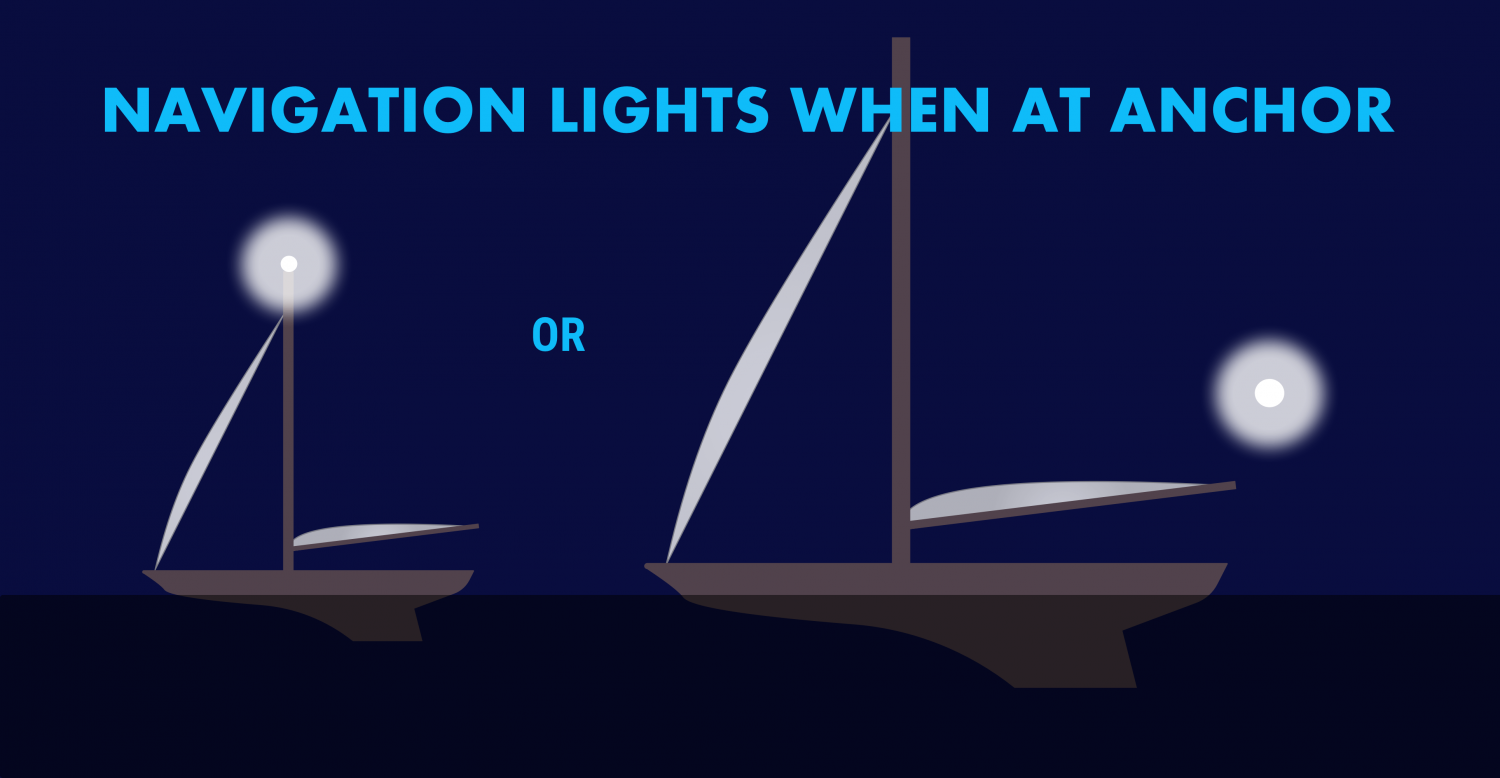
If your boat is large and has a very tall mast, you may wish to display another light closer to the waterline. Boats approaching in the dark may not see a light on a mast sixty or seventy feet in the air when they are close to your boat.
We use a simple garden path light on our stern when we anchor, left in a rod holder or flag socket. It comes on automatically at dusk and is a cheap and easy way to be more visible. There is no specific rule stating you can not display more lights than required, or the nature of any lights beyond the required all around light.
The COLREGS also specify that a round black "daymark" should be displayed in the rigging of any vessel at anchor. Very few small vessels observe this, however it is the correct display for a vessel in an anchorage.
If you tie to a mooring in a marked mooring area you are not required to display anchor lights, but there is no harm in doing so.
Identifying the Boats Around You
The other important reason to know your lights is to figure out what's going on around you at night. The water may be ablaze with white, red, green and other lights at night and they are your first key to avoiding collisions and problems.
All combinations of lights for fishing boats, commercial vessels, and so on are outside this post‘s scope. The odds are small you will encounter a submarine, seaplane or hovercraft at night, but there are regulations regarding specific lighting for each of those vessels!
There are a few fundamentals to help you figure out what that is you see on the horizon, which way it is going, and whether it is a danger to you.
Port Wine is Red
The fundamental rule is that red sidelights will ALWAYS be on the port side of a vessel, and green lights will always be on starboard. However, some vessels can use all around red and green lights for other purposes, though those will be higher than sidelights.
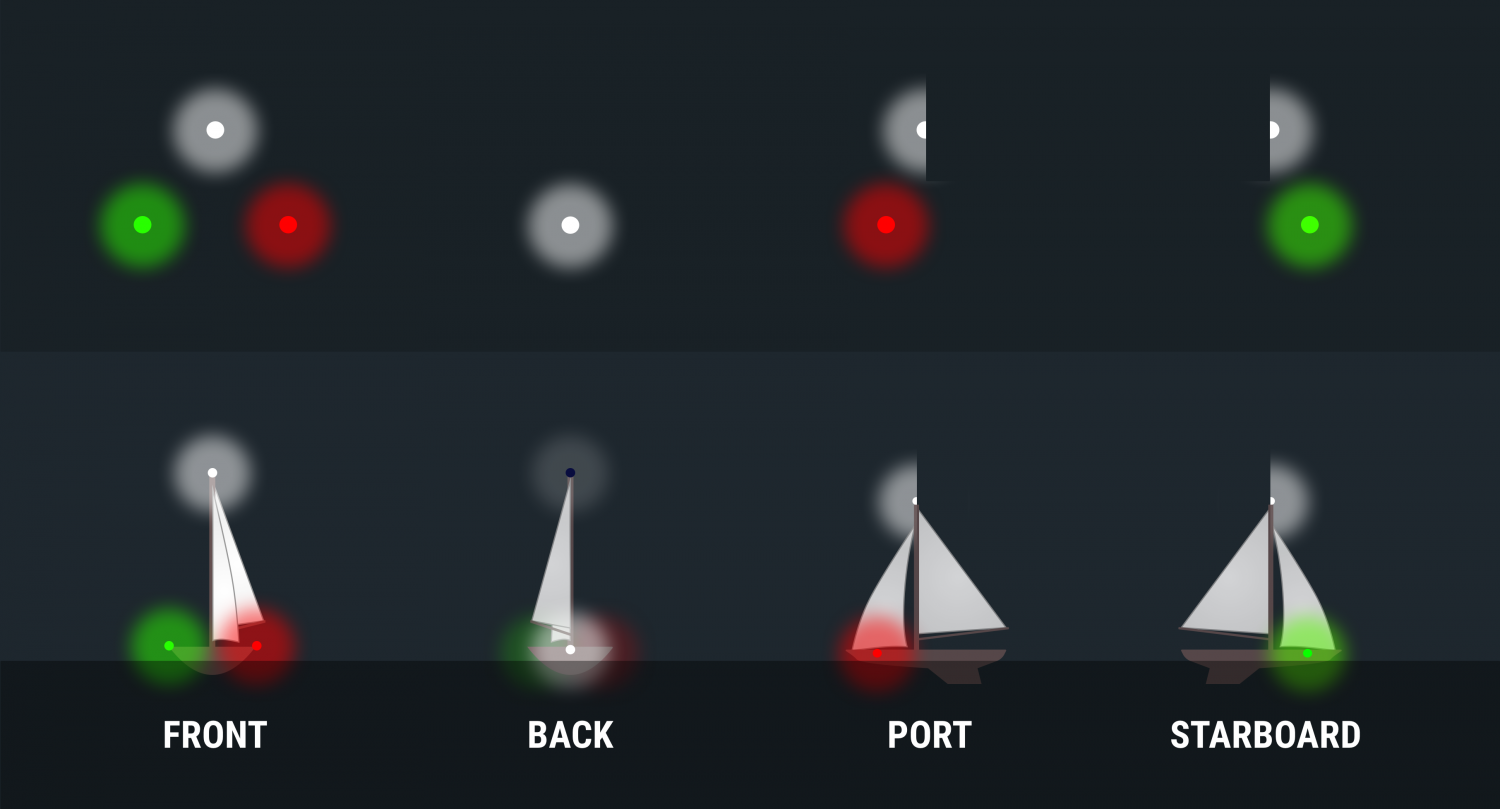
The light‘s on a ship is not important, some large tankers and freighters will have their sidelights far aft and put them on the superstructure for better visibility. It is not safe to assume that sidelights you can see are on the bow of large vessels.
When you can see the color, you know which way the bow is pointing. If it's red, it's pointing more or less to the left and will travel in that direction. A green light shows it is heading more or less to your right.
If you can see the red and green lights at the same time, you are looking directly at the bow of the vessel. When you are far away, this isn‘t as alarming as if you are close crossing. Seeing red and green lights together on a vessel is something you never want to see for long.
Be aware of red and green lights used in combination with other red, green and white lights. These may not be running lights and could have other significance.
Tankers, Freighters and Large Ships
Tankers, freighters and large ships will have side lights, a stern light and a masthead light. In addition, on vessels over 50 meters there will be a second masthead light further aft and higher than the forward light. The masthead light positions are a better tipoff to the bow direction and how far from the bow the sidelights might be. Remember - on a large vessel the sidelights may not be at the bow or even close to it.
USCG Inland Rules allow for a second all-around white light on large vessels on the Great Lakes instead of a second masthead light.
Fishing Boats
Fishing boats engaged in fishing will have more complex light displays. When they aren't fishing, they will show lights like any power vessel, but Rule 26 spells out light combinations that vary by the fishing activity being done.
In general:
- Boats which are Trawling but not making headway will display a green all-around light over a white all-around light, and a masthead light aft of these lights. Boats making headway while trawling will show these lights, plus sidelights and a stern light.
- A vessel fishing other than trawling will show a red all-around light over a white all-around light. When making way they will also show sidelights and a stern light.
- If a vessel has gear more than 150 meters away from the boat, it will show a second all around light in the direction of the gear.
The best rule is to give fishing boats as wide a berth as you can at night. They're easy to pick out if you check the top light configurations but their course may be difficult to predict.
Towing and Pushing
Towed vessels can be the most dangerous to cross, but they have the most lights to tell you what is happening. Refer to COLREGS or the USCG Rules of the Road Rule 24 for all combinations
You can pick a tow/push vessel out with the following lights:
- Two or three masthead lights in a vertical line. Three masthead lights shows a tow over 200 meters. Additional masthead lights may show for larger tow vessels.
- A towing light (yellow light with the same characteristics as a stern light) directly above the stern light.
- The will also have side lights and a stern light.
- The towed vessel will show sidelights and a stern light.
Lighting may vary under USCG inland rules, where towing lights may replace stern lights. Learn these differences if this is your regular cruising ground.
If you think there is a tow ahead of you, always go well behind the aft most set of lights. Never go between a tow and avoid crossing ahead if possible as it may restrict their maneuverability.
Special Situations
There are several rare situations you may encounter. As a general rule, if there are a lot of lights and you don't understand them look for the sidelights on a moving vessel. If you can find them and figure out the direction it is moving, it makes the vessel easier to avoid. Stay well clear of lights you do not understand if you can avoid them without risk.
Most of these signals are used by larger, commercial vessels and you will not need them.
They use these light combinations with other light combinations. For example a towing vessel may also be restricted in maneuverability, and a vessel constrained by draft will show running lights if moving.
- Not Under Command - two all around red lights in a single line
- Restricted in Ability to Maneuver - red, white then red in a single line
- Constrained by draft - three all around red lights
Did you find the answer to your specific question?
👍 11 👎 12
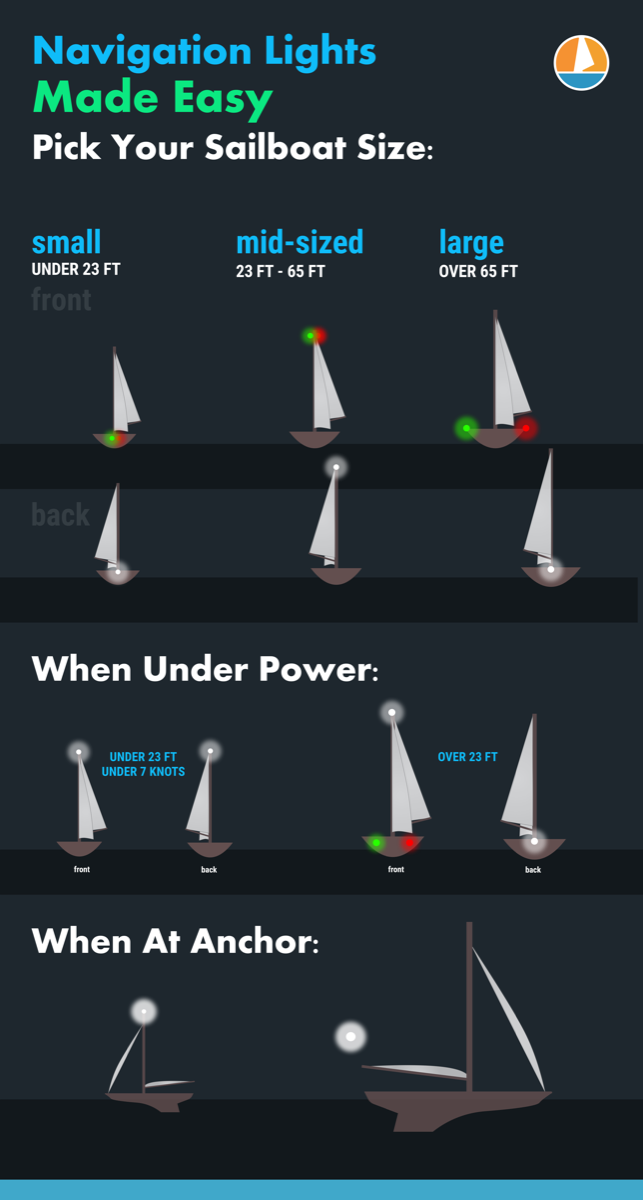
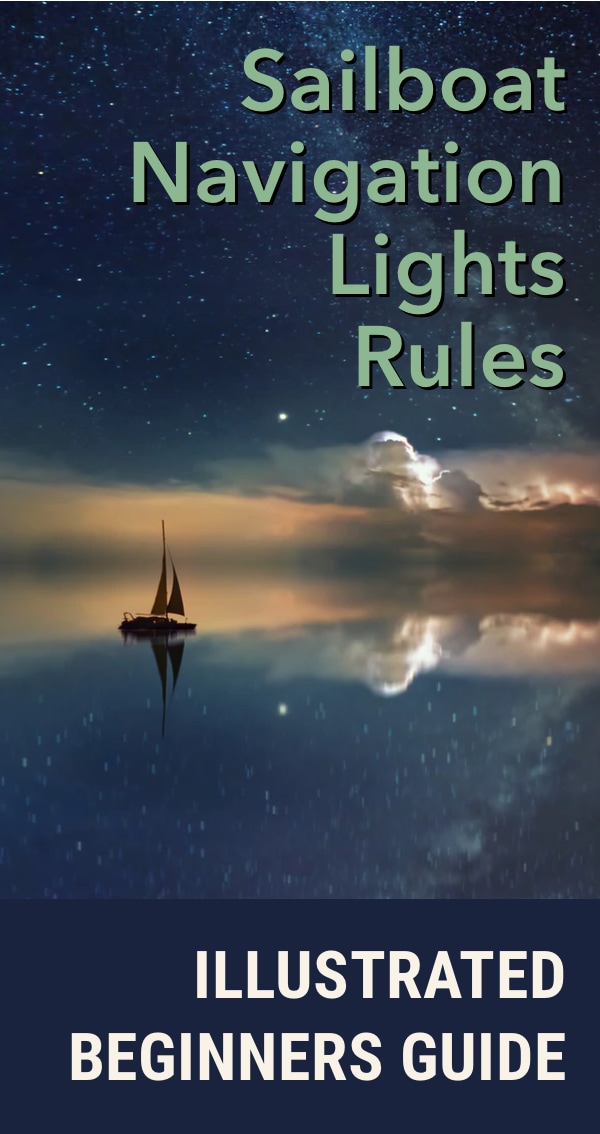
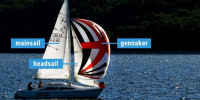
Leave a comment